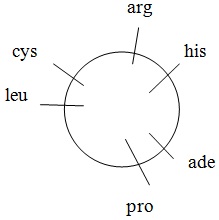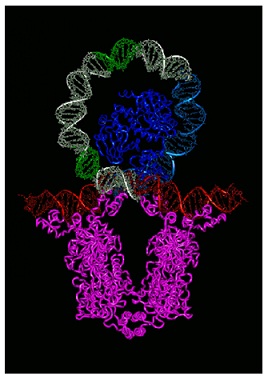Question 1: Five Hfr strains A though E are derived from a single F+ strain of E. coli. The following chart shows the entry times in minutes of the first five markers into an F- strain when each is used in an interrupted mating experiment.
a) Draw a map of the F+ strain, indicating the position of all the genes and the distance between them in minutes

Question 2: An ade+ arg+ cys+ his+ leu+ pro+ bacterial strain is known to be lysogenic for a new phage but the site of the prophage is not known. The bacterial map is:

The lysogenic strain is used as a source of phage and the phages are used to infect a bacterial strain with the genotype ade- arg- cys- his- leu- pro-. After a short incubation samples of these bacteria are plated on six different selective media (see table below; – indicates that supplement was not added, + means it was added) but colonies grew only on media 3 and 5.
a) Explain the genetic process that this illustrates.
b) Indicate on the map where the prophage is integrated.

Question 3: In a generalize transduction experiment, phages are collected from the donor strain of E. coli (genotype cys+ leu+ thr+) and used to infect a recipient strain (genotype cys- leu- thr-). The initial plating is on media supplemented leu and thr. 100 colonies grow.
a) What are the possible genotypes of the colonies on the original plate?
b) The colonies from the original plate are replica plated on the media in the table below. Describe the genotypes that could theroretically grow on each of these media
c) Use the data in the table to:
- Draw a map of the three genes and indicate which two are closer together.
- State what the actual genotypes are on each plate.
Media supplement Leu thr None
Number of colonies 5 56 0
Question 4: In a newly discovered organism the Histidine operon is negatively regulated. It contains the structural genes for the enzymes needed to synthesize Histidine and the repressor protein is also coded within the operon. In other words, the polycistonic mRNA molecules that codes for the other proteins needed to synthesize Histidine also codes for the repressor protein. Synthesis of this mRNA is controlled by a single operator regulating the activity of a single promoter. The Allosteric effector molecule for the repressor is the tRNA bound to Histidine. The tRNA is not coded for by the operon. A collection of mutants with the following defects is isolated.
a) Determine which of these would synthesize the enzymes for Histidine synthesis
b) Determine which would be cis-dominate mutations to the wild-type allele
c) Determine which would be cis-recessive to the wild-type allele in a partial diploid
- The promoter can not bind to RNA polymerase.
- The operator is mutated such that it will no longer bind the repressor.
- The DNA binding domain of the repressor is mutated suich that it no longer binds to DNA.
- The allosteric site of the repressor protein is mutated such that it no longer binds to tRNAHIS.
- The allosteric site is mutated such that is binds to the tRNA without His bound.
Question 5: You isolate a new strain of bacteria that cannot use any other sugar besides glucose. You clone the genes from this strain for the enzymes necessary to ferment arabinose and lactose and find these are completely wildtype. What gene would you test next?
Question 6: Below is a picture of the current model of the interaction between the lac repressor, CAP, and the DNA of the operators and promoter regions. The repressor is shown in pink, CAP is blue the operator DNA is in red and the CAP binding site is in Blue. The Shine Dalgarno sequences are shown in green. Explain how the bending and looping of the DNA may affect the RNA polymerases ability to initiate transcription.
